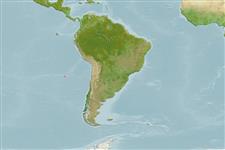>
Perciformes/Scorpaenoidei (Scorpionfishes) >
Plectrogeniidae (Stinger flatheads)
Etymology: Plectrogenium: Greek,plektron = anything to strike with, spur + Greek, geny, -yos = face (Ref. 45335); barsukovi: Named for V.V. Barsukov.
Eponymy: Vladimir Viktorovich Barsukov (1922–1989) was a Russian Ichthyologist, who was a Senior Research Scientist at the Zoological Institute of the USSR Academy of Science and Director of its Ichthyology Laboratory for seventeen years. [...] (Ref. 128868), visit book page.
Environment: milieu / climate zone / depth range / distribution range
Ökologie
seewasser bathydemersal; tiefenbereich 290 - 310 m (Ref. 35728). Deep-water
Southeast Pacific: Nazca Ridge.
Size / Gewicht / Alter
Maturity: Lm ? range ? - ? cm
Max length : 5.2 cm SL (female)
Kurzbeschreibung
Bestimmungsschlüssel | Morphologie | Morphometrie
Rückenflossenstacheln (insgesamt) : 12; Rückenflossenweichstrahlen (insgesamt) : 7; Afterflossenstacheln: 3; Afterflossenweichstrahlen: 5; Wirbelzahl: 25 - 27. Body slim, with greatest depth 4.4-4.5 times SL. Soft dorsal fin with a large dark spot. Interorbital space narrow, 5.6-6.1 times HL; with long nuchal spines (25-28% of the horizontal diameter of the orbit) (Ref. 35728).
Life cycle and mating behavior
Geschlechtsreife | Fortpflanzung | Ablaichen | Eier | Fecundity | Larven
Mandrytsa, S.A., 1992. The new species and new records of fishes from the genera Phenacoscorpius and Plectrogenium in the Pacific, Atlantic and Indian Oceans. J. Ichthyol. (7):100-109. (Ref. 35728)
IUCN Rote Liste Status (Ref. 130435: Version 2024-2)
Nutzung durch Menschen
Fischereien: nicht kommerziell
Tools
Zusatzinformationen
Download XML
Internet Quellen
Estimates based on models
Preferred temperature (Ref.
123201): 10.9 - 11.2, mean 11 °C (based on 5 cells).
Phylogenetic diversity index (Ref.
82804): PD
50 = 1.0000 [Uniqueness, from 0.5 = low to 2.0 = high].
Bayesian length-weight: a=0.00389 (0.00180 - 0.00842), b=3.12 (2.94 - 3.30), in cm total length, based on all LWR estimates for this body shape (Ref.
93245).
Trophic level (Ref.
69278): 3.3 ±0.3 se; based on size and trophs of closest relatives
Widerstandsfähigkeit (Ref.
120179): mittel, Verdopplung der Population dauert 1,4 - 4,4 Jahre. (Assuming tmax>3).
Fishing Vulnerability (Ref.
59153): Low vulnerability (10 of 100).
